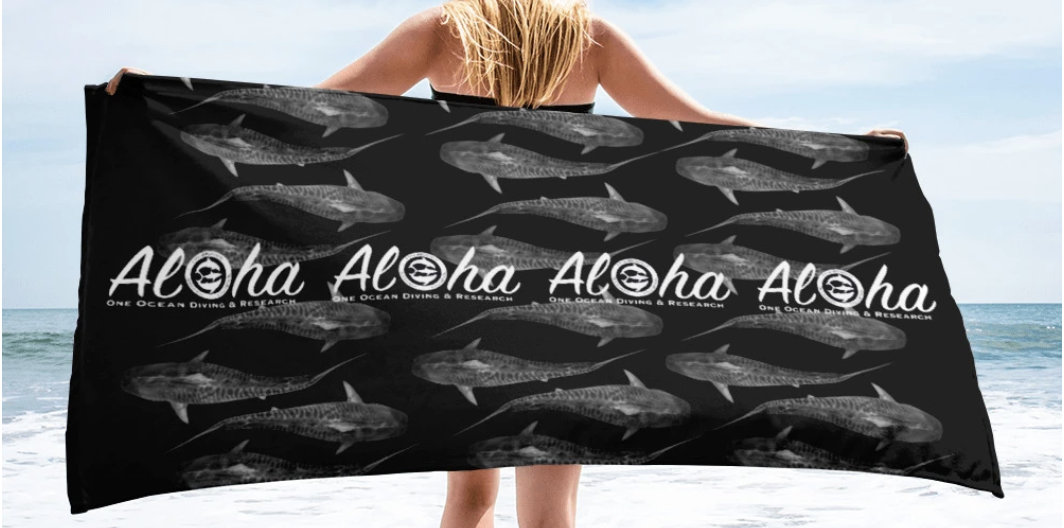Lots of nearshore species of sharks in Hawaiʻi actually have different names in ʻōlelo hawaiʻi (Hawaiian language); and Hawaiians understood the difference between the species of sharks they would regularly see while fishing, swimming, etc. In this blog post we will highlight some of the sharks that had Hawaiian names, their cultural significance and a little bit about their biology.
THRESHER SHARK
The first shark on our list is the thresher shark. There are three species of thresher sharks found around the Hawaiian islands: the pelagic thresher (Alopias pelagicus) up to 11ft, the bigeye thresher shark (Alopias superciliosus) up to 15ft, and the common thresher shark (Alopias vulpinus) up to 18ft. The Hawaiian name for thresher shark is manōʻula or laukāhuʻu. These are the only two surviving names associated with thresher sharks in Hawaiian culture, but that does not mean that Hawaiians did not have individual names for individual species. Hawaiian culture was passed on orally, so keep in mind that words and names could have been lost or forgotten. Manōʻula in Hawaiian language means red shark, but clearly the thresher shark is not red. ʻUla was a color reserved for aliʻi (kings) and represented royalty and strength. Another meaning for ʻula was the shortened name for the Hawaiian sea bird koaʻeʻula, also known as red-tailed tropic bird (Phaethon rubricauda). Manōʻula (thresher shark) and koaʻeʻula (red-tailed tropic bird) both share a similar slender tail. Perhaps manōʻula was named after koaʻeʻula, or vice versa because they both bare distinctive long tails. Thresher sharks use their long tails to strike and stun their prey while hunting.
WHALE SHARK
Our second shark is the Whale shark / Lelewaʻa (Rhincodon typhus). 📸: @juansharks . Aloha mai kākou! The second shark on the list is the whale shark (Rhincodon typhus), which can grow up to 60 feet in length, and can be found in tropical oceans around the world. Whale sharks are harmless, and are one of the few sharks that feed solely on plankton. The word for whale shark in ʻōlelo hawaiʻi (Hawaiian language) is lelewaʻa, which literally means canoe jump. The whale shark was described by Hawaiian historian Samuel Kamakau, as lelewaʻa, and one of the basic sharks found in Hawaiian waters. Lelewaʻa is described in the Hawaiian dictionary as literally jumping from canoe to canoe as sport for surfing to the shoreline. Kamakau inferred that Hawaiians could have possibly encountered a whale shark near shore while partaking in the sport of “lelewaʻa”, jumping on the back of a whale shark instead of their canoe, and riding the whale shark back to shore. Hawaiians named the whale shark after a popular sport that took place back in the day, lelewa'a.
GRAY REEF SHARK
Our third and last shark on our list today is the of Gray Reef Shark / Manō (Carcharhinus amblyrhynchos), which can grow up to 6 feet, and is widely distributed across the Indo-Pacific region. The gray reef shark is one of the most abundant sharks found around the Northwestern Hawaiian Islands, but seems to be more restricted to certain areas in the main Hawaiian Islands; more frequently sighted off Niʻihau or Molokini crater in Maui (Wetherbee et. al, 1997). Large social aggregations of pregnant female gray reef sharks have been well documented in the Northwestern Hawaiian Islands around Kauō (Laysan Island) and Kalama atoll (Johnston Atoll). Aggregation behaviors of the gray reef shark is poorly understood, but possible functions have been proposed: 1) reproduction, 2) mate selection, 3) energy conservation, 4) protection from large predators (Economakis, 1997). Perhaps pre-western contact, before boats, coastal runoff and noise pollution, gray reef sharks used to have natural aggregation sites around the shallow bays of the main Hawaiian Islands. Moʻolelo (legends) tells of kahu manō (shark guardians or shark keepers), whose sole job was to care for sharks. Tasks would included feeding, cleaning, and keeping company with family ʻaumakua, literally treating them as family members. Perhaps the manō in these legends could be about Hawaiian gray reef sharks, as they have been scientifically documented to aggregate in huge numbers near shore; where Hawaiians could have easily come in contact with them. This could also explain the reason why Hawaiians built heiau (temples, places of worship) in the ocean or near shore, devoted to the shark gods and ʻaumakua. The name for gray reef shark in ʻōlelo (Hawaiian language) has been lost, and they are usually just referred to as manō.




